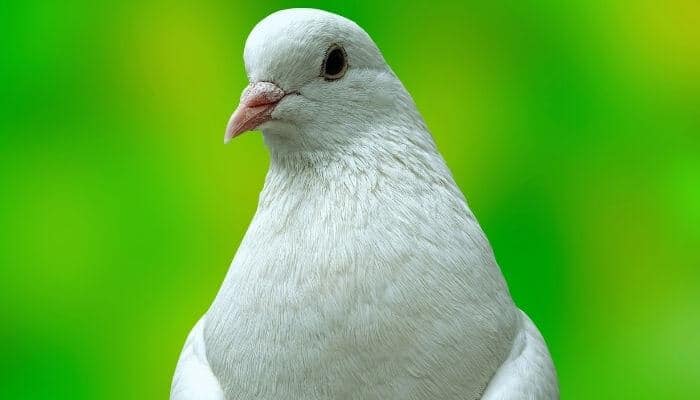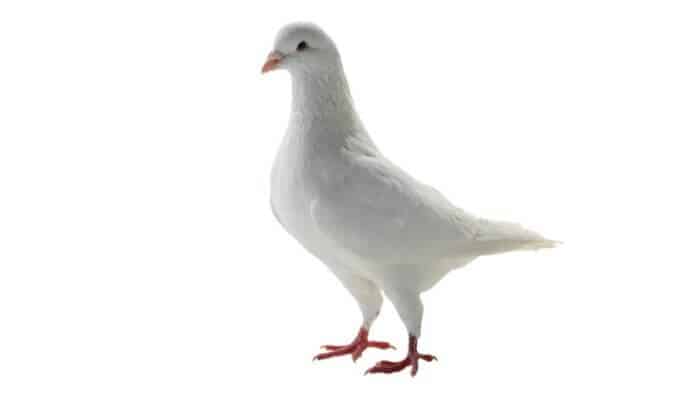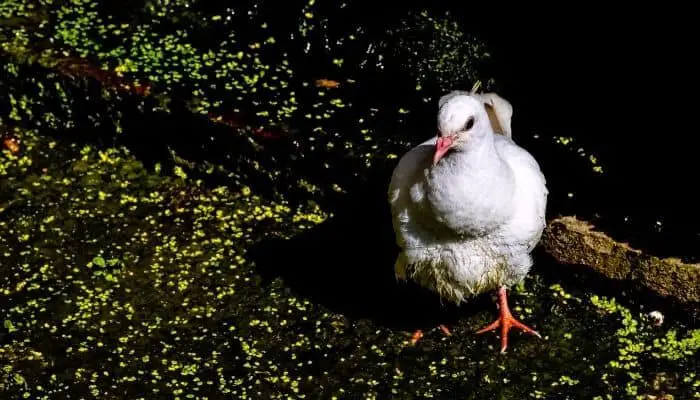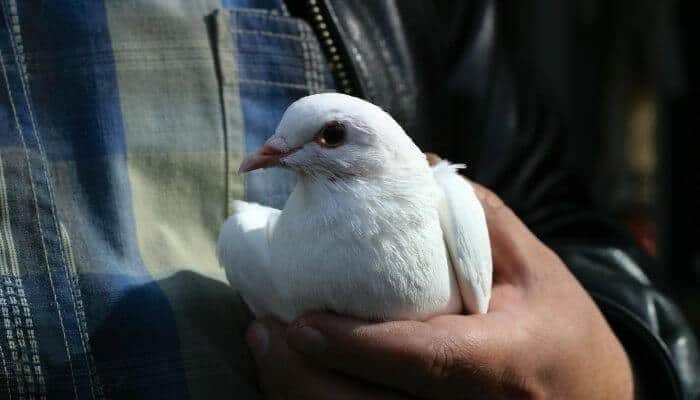A white pigeon, also known as a release dove, is a type of domesticated rock dove.
The primary purpose of breeding white pigeons is for using them as the climax of a celebration, releasing them into the air in a beautiful fashion, hence the secondary name of release dove.

Pigeon or Dove?
This is a question that is asked by many. Is a white pigeon a dove or is a dove a white pigeon?
A dove is a pigeon and vice versa.
The terms dove and pigeon are interchangeable – most birds in the Columbidae family can be called either although some have names containing a specific dove or pigeon reference.
It has become so that society associates the word dove with a white bird – particularly in the UK, Europe and Australasia. It’s less so in the USA where one of the most common birds overall is the ring-necked dove.
Origins of the White Pigeon
Although it is known that white pigeons have existed in the world since antiquity, today’s white doves and pigeons are barbary doves that have been selectively bred to make the albino genes dominant.
Barbary doves are also naturally small birds, and this is another trait that breeders attempt to accentuate in the white pigeon.

White doves and pigeons have long held significant symbolism in religion and spiritualism and today most of them are bred to be used commercially.
The notion of releasing birds in a ceremonial fashion dates all the way back to the 5th century, but the move towards breeding pure white pigeons for even starker and bolder symbolism is something that has happened over the generations.
Breeding of the species is now very much focused on maintaining the pure whiteness of their colouring, along with the smallness of their size to make a dove release ceremony as easy and delicate as possible.
In recent years, however, there has been a big rise in awareness of just how unethical and dangerous the process of releasing ceremonies can be.
Distribution And Habitat of the White Pigeon
Distribution is pretty much worldwide but most usually in domestic settings.
If you see a white pigeon in the wild, it is most likely to have not found its way home after a release. They are ill-equipped to survive in the wild which is one of the arguments against release ceremonies.
Appearance of the White Pigeon
The white pigeon is exactly as you see it depicted in its many symbolic uses. A rather dainty, elegant looking bird, they are completely white in colour, with pink legs and a petite beak.

They are smaller than most common pigeon breeds.
Character of the White Pigeon
The symbolism of the white pigeon when being used in release ceremonies is that of peace, love and unity, but unfortunately, the act of releasing them promotes the opposite of that.
Though dove releases are a very familiar style of celebration across the world, the truth is that whilst the species might look the part, it isn’t able to cope with the stresses and struggles of being let loose in an urban environment.
Trained homing pigeons are sometimes used and are able to navigate home, but this isn’t always the case with white pigeons.

White pigeons are not bred with homing instincts or flight abilities and as domesticated birds will not fare well in the wild.
That they are white all over is another disadvantage as it makes them stand out as prey, particularly for raptors such as kestrels.
There are numerous accounts of white doves being attacked immediately after their release in public squares. The Vatican used to schedule releases for special church holidays but after various incidents including one very public scene where a dove was attacked by a seagull, St. Peter’s no longer sees dove releases.
White pigeons are gentle, unassuming, inexperienced birds but when they are used in a release ceremony, they are literally thrown to the wind.
Diet of the White Pigeon
A white pigeon enjoys the same kind of diet as most other pigeons. The usual foods that make up the regular eating habits of a white pigeon include:
- Seeds
- Grains
- Berries
- Leafy greens
- Chopped up fruit
- Chopped up vegetables
They also need a constant supply of fresh drinking water and grit to aid digestion.
Mating And Breeding White Pigeons
The mating and breeding of white pigeons is very much controlled by the breeder in question.
Pairs will be matched with a focus on maintaining the pure white colour that the breed is famous for, along with striving to achieve the small size that is desirable for the purposes of release ceremonies.
After the mating of matched pairs, the process is the same for all pigeons.
The female will lay one or two eggs, the chicks will hatch after 18 days, and they are fed crop milk for the first few days. They will then take up to six weeks to be ready to leave the nest but at some point, the breeder will begin the process of readying them for release.
Taking Care of White Pigeons
In basic terms, the care of a white pigeon in captivity is very similar to any other breed of pigeon.

They need sufficient room to fly, sufficient soft materials on the ground, sufficient perching/nesting areas and regular food and water supply.
The Big Question
The wider context of white pigeon breeding raises the question of whether dove release ceremonies are ethical.
True bird lovers are among those who feel strongly that the consequences of lost and dying white pigeons far outweigh the beauty of a brief release, so it will be interesting to track mass public opinion in the coming years.
